
I) The debtor declared bankrupt
In the books of Mlachake ltd by 31 December 2004, the balance sheet shows
debtor?s figure of Sh. 200,000. This was on assumption that such
debtors would be recoverable. The declaration of the debtor bankrupt reduced
the chances of realization of the debt. However this declaration is done after the
balance sheet date. In accordance to International Financial Reporting Standards,
this is an event after the balance sheet and it provides additional evidence of the
conditions as they existed at the balance sheet date. This therefore is an adjusting
event and therefore the following adjustments should be made:
(I) 75% of the debt (Sh 200,000) should be written off in the income
statement as a bad debt
(II) Bad debts recovered of 25% of Sh 200,000 should be recognised. However, if
the financial statements had been finalised to the point that the reports had been
sent to stakeholders and shareholders, then it should be disclosed by way of note.
II) The inventory which got damaged
Such inventory which has been damaged should be valued at the lower of cost and
net realizable value. Further the cost of repairing the inventory should be
incorporated in the cost of the inventory. As such, this would be consistent with
Accounting Standard No.2 which deals with inventories.
III) The secured order of Ksh.12 million
In accordance to the Prudence concept, revenue/gains are recognised if their
realisation can be determined with reasonable certainty. In this case, the fact that a
foreign based company secured an order for goods to be later demonstrates
commitment of the customer to buy the goods. However the commitment is not
enough to warrant the recognition of the sale in our books of account.
Therefore it was not proper for the sale to be recognised in December as it was
since as at December 19th the Sale was still uncertain.
Those goods should only have been recognised for the month of January which is
when their sale became certain.
Mutiso answered the question on November 19, 2018 at 07:01
-
Citing suitable examples, briefly explain of the following terms:
(i) Accounting concepts
(ii) Accounting policies
(iii) Accounting standards
(Solved)
Citing suitable examples, briefly explain of the following terms:
(i) Accounting concepts
(ii) Accounting policies
(iii) Accounting standards
Date posted:
November 19, 2018
.
Answers (1)
-
Identify with reasons, one party who may be interested in each of the following ratios:
(i) Current ratio
(ii) Net profit margin
(iii) Stock turnover
(Solved)
Identify with reasons, one party who may be interested in each of the following ratios:
(i) Current ratio
(ii) Net profit margin
(iii) Stock turnover
Date posted:
November 19, 2018
.
Answers (1)
-
Explain the importance of ratio analysis to a business enterprise
(Solved)
Explain the importance of ratio analysis to a business enterprise.
Date posted:
November 19, 2018
.
Answers (1)
-
The following balances were extracted from the books of Katee Ltd. for the month of April 2005
(Solved)
The following balances were extracted from the books of Katee Ltd. for the month of April 2005:
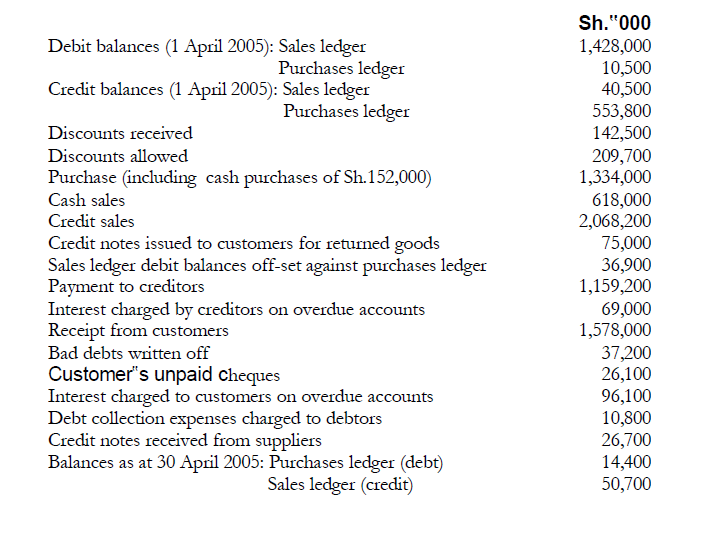
(i) Sales ledger control account for the month ended 30 April 2005.
(ii) Purchases ledger control account for the month ended 30 April 2005.
Date posted:
November 19, 2018
.
Answers (1)
-
Explain the advantages of maintaining control accounts
(Solved)
Explain the advantages of maintaining control accounts.
Date posted:
November 19, 2018
.
Answers (1)
-
Faida Commercial Bank Ltd. offered 200,000 ordinary shares for sale to the public at a par value
of Sh.25 each on 1 April 2004, payable as...
(Solved)
Faida Commercial Bank Ltd. offered 200,000 ordinary shares for sale to the public at a par value
of Sh.25 each on 1 April 2004, payable as follows:
- On application, Sh.5 due on 15 April 2004
- On allotment, Sh.5 due on 30 April 2004
- On first call, Sh.7.50 due three months after allotment
- On second and final call, Sh.7.50 due three months after the first call.
Additional information:
1. The company received applications for 530,000 shares on the due dates. Applications for
30,000 shares were rejected and the application money refunded. The rest of the applicants
were allotted shares on a prorate basis.
2. One month after allotment, one shareholder of 2,000 shares remitted Sh.25,000 as calls in
advance. The rest of the calls were received on the due dates except for money due on
second and final call for Sh.8,000 shares which was paid three months late.
3. The surplus application monies were treated as calls in advance.
4. The company‟s articles of association provided for charging of interest on calls in arrears at
10% per annum.
Required:
Ledger accounts to record the above transactions.
Date posted:
November 19, 2018
.
Answers (1)
-
The following draft accounts have been prepared by the treasurer of Wasomaji Members Club
(Solved)
The following draft accounts have been prepared by the treasurer of Wasomaji Members Club:
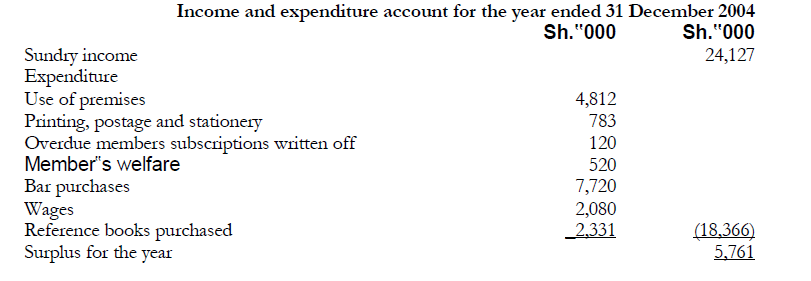
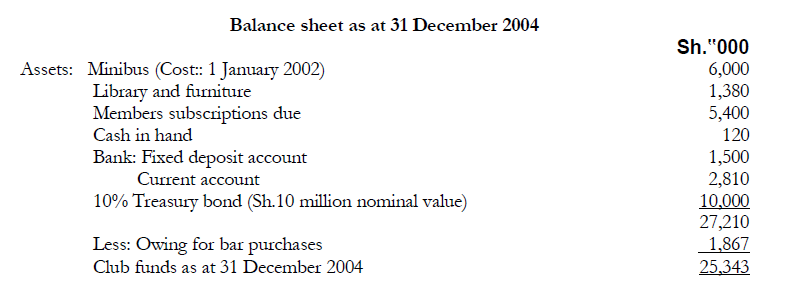
Additional information:
1. The treasurer had little accounting knowledge and some figures appearing in the draft
accounts were incorrect.
2. The club‟s policy on outstanding subscriptions was to write off amounts
outstanding for a period exceeding five years. As at 1 January 2004, subscriptions
outstanding from members were Sh.3,120,000
3. The club‟s premises were purchased on 1 October 2004 for Sh.4 million.
This amount was posted to the use of premises account in the draft accounts.
4. The treasury bond was purchased for Sh.9.3 million on 1 January 2000 by utilizing
donations earmarked for a member‟s welfare fund. Up to 31 December
2003, the income received from this investment had been distributed to members. The
income for the year ended 31 December 2004 was included under sundry income as
resolved at the annual general meeting held on 10 April 2004.
5. The club runs a bar for the benefit of members. This bar sells stock at a mark-up of
30%. The income from bar sales amounting to Sh.9,927,000 was included under sundry
income. There was no opening stock as at 1 January 2004 and the club owed suppliers
Sh.1,625,000 as at 1 January 2004. Bar closing stock as at 31 December 2004 was not
ascertained.
6. The balance of the fixed deposit account as at 1 January 2004 amounted to Sh.1,500,000
reflected in the balance sheet as at 31 December 2004. No account was taken of interest
amounting to Sh.100,000 which had been credited to the fixed deposit during the year.
7. As at 1 January 2004, cash in hand was Sh.100,000 and the bank current account was
overdrawn by Sh.893,000.
8. The reference books purchased during the year are to be capitalized as part of the
library. Library and furniture are to be revalued to Sh.5,000,000
9. Depreciation is to be provided based on the cost of the assets as follows:
Club premises - 2% per annum
Minibus - 20% per annum
Required:
(a) Income and expenditure account for the year ended 31 December 2004.
(b) Balance sheet as at 31 December 2004.
Date posted:
November 19, 2018
.
Answers (1)
-
Chacha and Mushi are in partnership sharing profits and losses equally. They manufacture shoes whose brand name is "DAWO". Their trial balance as at 31...
(Solved)
Chacha and Mushi are in partnership sharing profits and losses equally. They manufacture shoes whose brand name is "DAWO". Their trial balance as at 31 December 2004 was as follows:
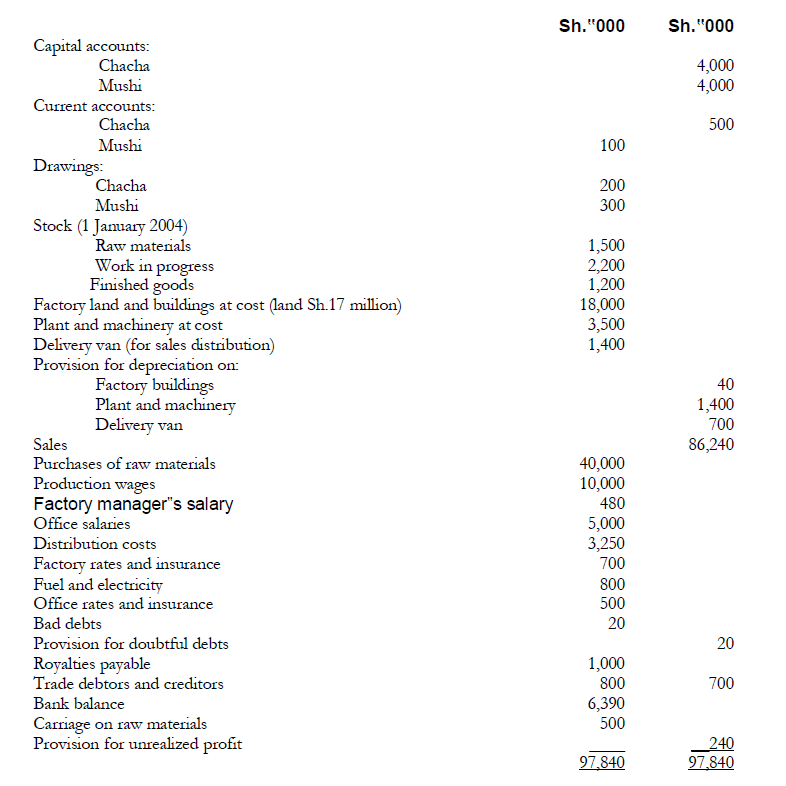
Additional information:
1. Stock at 31 December 2004 was valued as follows:
Sh. "000"
Raw materials 2,000
Work in progress 4,200
Finished goods 1,000
2. Insurance prepaid (31 December 2004)
Sh. "000"
Factory 200
Office 35
Rates owing (31 December 2004)
Sh."000"
Factory 500
Office 25
3. Depreciation is provided at the following rates:
Factory buildings – 2% per annum on cost
Delivery van – 25% per annum on cost
Plant and machinery – 20% per annum on cost
4. Provision for doubtful debts is to be maintained at 5% of the debtor‟s balance
at the end of the year.
5. Manufactured goods are transferred to the warehouse at cost plus 25% of factory profit
6. The partnership agreement has the following provisions:
(i) A commission of 10% to Mushi based on factory profit while Chacha is
entitled to a commission of 10% based on net profit from trading.
(ii) Partners are allowed interest on their fixed capitals at a rate of 10% per
annum.
(iii) Chacha had guaranteed Mushi a total income from the partnership of
not less than Sh.15,000,000 per annum.
Required:
(a) Manufacturing, trading and profit and loss and appropriation accounts for the year ended 31
December 2004.
(b) Balance sheet as at 31 December 2004.
Date posted:
November 19, 2018
.
Answers (1)
-
The summarized financial statements of Baraka Enterprises Ltd. are as follows
(Solved)
The summarized financial statements of Baraka Enterprises Ltd. are as follows:

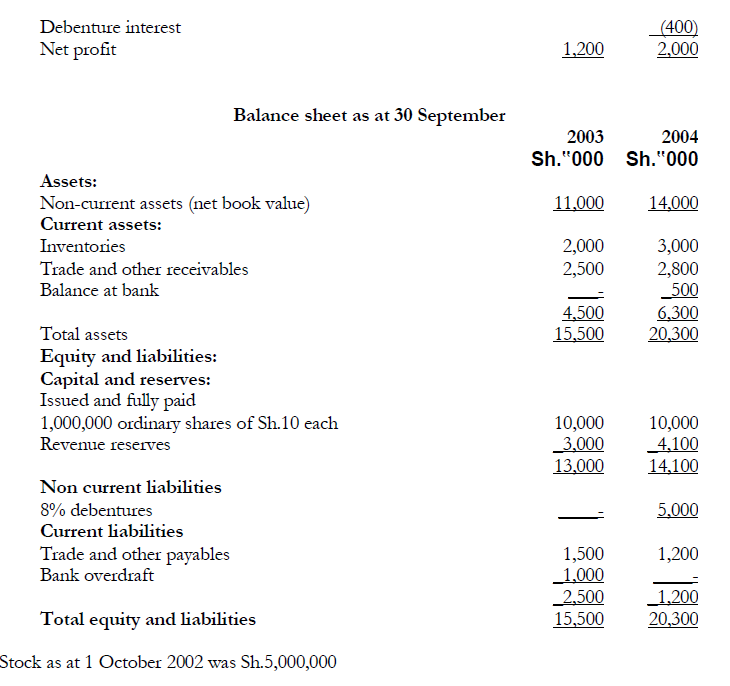
Required:
(i) For each year, calculate the following:
(a) Gross profit margin
(b) Inventory turnover
(c) Return on equity
(d) Return on assets
(e) Acid test ratio
(f) Current ratio
(g) Financial leverage
(ii)Comment on the liquidity position of the company giving possible reasons for the change.
Date posted:
November 19, 2018
.
Answers (1)
-
Explain the meaning of prudence concept showing how this is applied in stock valuation
(Solved)
Explain the meaning of prudence concept showing how this is applied in stock valuation.
Date posted:
November 19, 2018
.
Answers (1)
-
The trial balance of Plastics Ltd as at 31 October 2004 is as follows
(Solved)
The trial balance of Plastics Ltd as at 31 October 2004 is as follows:
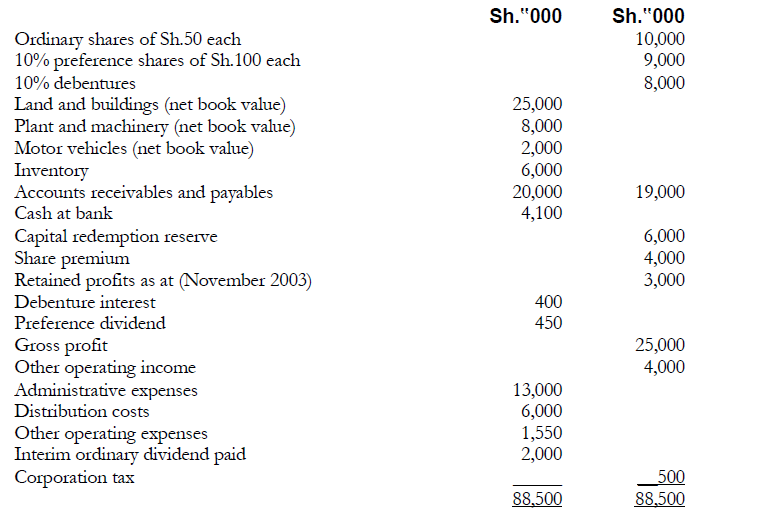
Additional information:
1. A building whose net book value is currently Sh.5 million is to be revalued to Sh.9 million
2. A final ordinary dividend of Sh.2 million is proposed.
3. The balance on the corporation tax for the current year is estimated at Sh.3 million.
Required:
(i) Income statement for the year ended 31 October 2004.
(ii) Balance sheet as at 31 October 2004.
Date posted:
November 19, 2018
.
Answers (1)
-
Distinguish reserves from share capital
(Solved)
Distinguish reserves from share capital.
Date posted:
November 19, 2018
.
Answers (1)
-
An extract from the balance sheet of Kimwa Construction Ltd as at 30 June 2003 showed the
following summary of property, plant and equipment
(Solved)
An extract from the balance sheet of Kimwa Construction Ltd as at 30 June 2003 showed the following summary of property, plant and equipment:

The following transactions took place during the year ended 30 June 2004:
1. The company incurred the following costs in acquiring new equipment

2. Property, plant and equipment disposed of during the year were as follows:
In addition, a new truck was acquired by trading in an old truck at an agreed value of
Sh.10.5 million and making an additional cash payment of Sh.15 million. The old truck
had cost Sh.15 million in July 2000.
3. The directors recommended a reclassification of some items of equipment to furniture.
These items had cost Sh.15 million and had accumulated depreciation of Sh.3 million.
4. The company‟s policy is to charge depreciation on a straight line basis at the following
rates:
Equipment 20% per annum
Furniture 12 ½ % per annum
Motor vehicles 30 % per annum
5. A full year‟s depreciation was charged in the year of acquisition but none in the year of disposal.
Required:
(a) Explain two other methods of charging depreciation that Kimwa construction Ltd could
have used.
(b) A property, plant and equipment disposal account for the year ended 30 June 2004.
(c) A property, plant and equipment movement Schedule for the year ended 30 June 2004
Date posted:
November 19, 2018
.
Answers (1)
-
On 31 October 2004, the cashbook of Mwea Enterprises Ltd. Showed a debit balance of Sh.1,710,000. This did not agree with the balance shown in...
(Solved)
On 31 October 2004, the cashbook of Mwea Enterprises Ltd. Showed a debit balance of Sh.1,710,000. This did not agree with the balance shown in the bank statement.
Upon investigation, the accountant discovered the following errors:
1. A cheque paid to Kindaruma for Sh.306,000 had been entered in the cashbook as
Sh.387,000
2. Cash paid into the bank by a customer for Sh.90,000 had been entered in the
cashbook as Sh.81,000
3. A transfer of Sh.1,110,000 to Central Savings Bank had not been posted to the cash
book.
4. A receipt of Sh.9,000 shown in the bank statement had not been posted in the
cashbook.
5. Cheques drawn amounting to Sh.36,000 had not been paid into the bank.
6. The cash book balance had been incorrectly brought down at 1 November 2003 as
a debit balance of Sh.1,080,000 instead of a debit balance of Sh.990,000
7. Bank charges of Sh.18,000 do not appear in the cash book.
8. A receipt of Sh.810,000 paid into the bank on 31 October 2004 appeared in the
bank statement on 1 November 2004.
9. A standing order of Sh.27,000 had not been recorded in the cash book.
10. A cheque for Sh.45,000 previously received and paid into the bank had been
returned by the customer‟s bank marked “account closed”.
11. The bank received a direct debit of Sh.90,000 from an anonymous customer.
12. Cheques banked had been totaled at Sh.135,000 instead of Sh.153,000.
13. A cheque drawn in favour of Nyaga for Sh.120,000 had been entered on the debit
side of the cashbook.
Required;
(i) Adjusted cash book as at 31 October 2004.
(ii) A bank reconciliation statement as at 31 October 2004.
Date posted:
November 19, 2018
.
Answers (1)
-
The bank statement and cashbook balances should agree, but sometimes these balances may not agree:
Required:
Discuss this statement and explain why it is important to prepare...
(Solved)
The bank statement and cashbook balances should agree, but sometimes these balances may not agree:
Required:
Discuss this statement and explain why it is important to prepare a bank reconciliation statement.
Date posted:
November 19, 2018
.
Answers (1)
-
Okech and Wanjala are in a partnership business that sells hardware. They share profits and
losses equally after allowing for an annual salary of Sh.600,000 to...
(Solved)
Okech and Wanjala are in a partnership business that sells hardware. They share profits and
losses equally after allowing for an annual salary of Sh.600,000 to Okech. Interest is allowed on
capital at 10% per annum. Their bookkeeper has produced the following list of balances as at 30
June 2004:
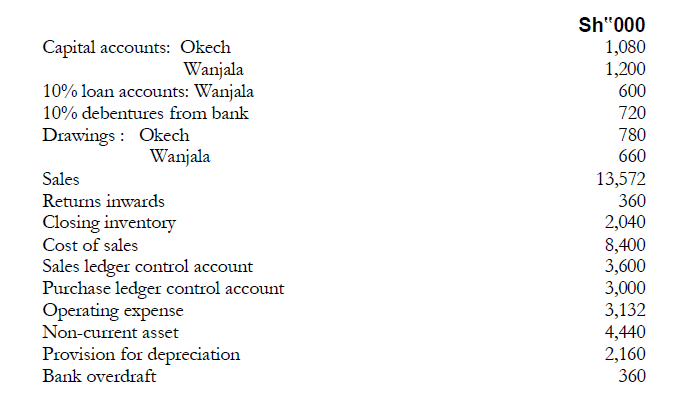
You ascertain that the bookkeeper is not sure whether the above balances are correct and on
further investigation you discover the following:
1. The sales ledger control account does not agree with the list of balances from the ledger
due to:
The sales return day book has been under cast by Sh.14,000 while a contra
entry with the creditors ledger for Sh.24,000 has been omitted from the control
account.
An invoice for Sh.240,000 was incorrectly entered in the sales day book as
Sh.24,000.
2. Wanjala had paid some business expenses amounting to Sh.60,000 from his personal
bank account while Okech had taken goods costing Sh.120,000 for his own use. No
entries have been made for these items.
3. A fully depreciated motor vehicle which cost Sh.600,000 was sold during the year for
Sh.120,000. The entry for the proceeds was only posted in the bank account.
4. The bookkeeper had understated the bank overdraft by Sh.240,000.
Required:
(a) A trial balance and a suspense account showing how the difference is accounted for.
(b) Trading, Profit and loss account for the year ended 30 June 2004.
(c) Balance sheet as at 30 June 2004.
Date posted:
November 17, 2018
.
Answers (1)
-
The book keeper of Bidii Ltd. prepared the following trial balance as at 31 December 2003:
(Solved)
The book keeper of Bidii Ltd. prepared the following trial balance as at 31 December 2003:
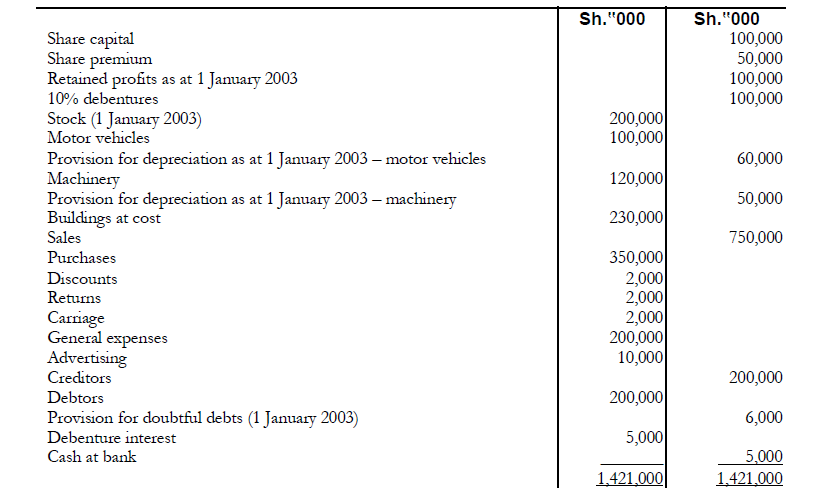
Additional information:
1. In an effort to simplify the accounting process, the book keeper posted both discounts
received and discounts allowed to the discounts account. He has also posted both
returns inwards and returns outwards to the returns accounts, and both carriage inwards
and carriage outwards to the carriage account. Discounts received, returns outwards and
carriage outwards were as follows:
Sh.
Discounts received 1,000,000
Returns outwards 1,000,000
Carriage outwards 1,000,000
2. The following items are already included in general expenses:
- Rates for the 12 months to 31 March 2004, Sh.4,000,000
- Insurance for the 12 months to 31 December 2003 amounted to Sh.2,000,000.
Half of this amount relates to the managing director‟s private expenses.
3. Accountancy fees of Sh.1,000,000 should be provided for
4. A debtor for Sh.20,000,000 has been declared bankrupt. The provision for doubtful
debts is to be made at 5% of the debtors.
5. Dividends of Sh.10,000,000 have been proposed by the board of directors.
6. Stock as at 31 December 2003 is valued at Sh.180,000,000
7. Depreciation of Sh.20,000,000 is to be provided on the motor vehicles and
Sh.10,000,000 on the machinery. The buildings are to be revalued upwards by
Sh.30,000,000
Required:
(a) Trading and profit and loss and appropriation accounts for the year ended 31 December
2003.
(b) Balance sheet as at 31 December 2003
Date posted:
November 17, 2018
.
Answers (1)
-
Kalamu and Karatasi have been trading in partnership for several years, sharing profits and
losses equally after allowing interest on their capitals at the rate of...
(Solved)
Kalamu and Karatasi have been trading in partnership for several years, sharing profits and
losses equally after allowing interest on their capitals at the rate of 8% per annum. On 1
September 2003, the manager of their business, Barua, was admitted as a partner and was to
share one fifth of the profits after interest on capital Kalamu and Karatasi were to share the
balance of the profits equally but guaranteed that Barua‟s share would not fall below
Sh.600,000 per annum.
Barua was not required to introduce any capital at the date of admission but agreed to retain
Sh.150,000 of his profit share at the end of each financial year to be credited to his capital
account until the balance reached Sh.750,000. Until that time, no interest was to be allowed on
his capital.
Goodwill was agreed at Sh.1,500,000 at 1 September 2003, but was not to be maintained in the
accounts. Land and buildings were professionally valued at Sh.2,840,000 on the same date while
the book value of equipment and motor vehicles was to be reduced to Sh.1,500,000 as at that
date.
Barua was previously entitled to a bonus of 5% of the gross profit. This bonus was payable half yearly.
The manager's bonus and the manager's salary were to cease when he became a partner.
The trial balance below was extracted as at 31 December 2003. No adjustments had yet been
made in respect of Barua's admission and the amount he introduced as his
contribution for goodwill had been posted to his current account. The drawings of all the
partners had been charged to their current accounts.
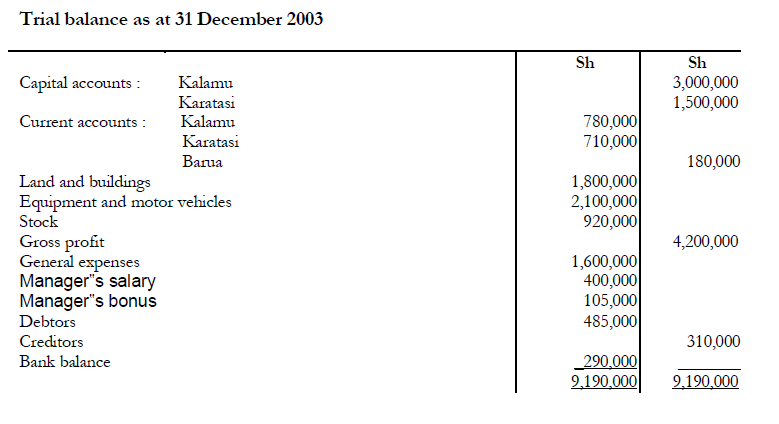
Additional information:
1. It is assumed that gross profit and general expenses accrued evenly throughout the year
except that Sh.100,000 of the general expenses relate to a bad debt that arose in the period
after Barua‟s admission. The balance of the general expenses accrued evenly.
2. Depreciation is to be charged on equipment and motor vehicles at the rate of 20% per
annum on the book value. No depreciation is to be charged on land and buildings.
Required:
(a) Profit and loss account for the year ended 31 December 2003
(b) Partner‟s capital accounts as at 31 December 2003.
(c) Partner‟s current accounts as at 31 December 2003.
Date posted:
November 17, 2018
.
Answers (1)
-
The trial balance of Amanda Ltd as at 30 April 2004 did not balance. On investigation, the
following errors were discovered:
1. A loan of Sh.2,000,000 from...
(Solved)
The trial balance of Amanda Ltd as at 30 April 2004 did not balance. On investigation, the
following errors were discovered:
1. A loan of Sh.2,000,000 from one of the directors has been correctly entered in the
cashbook but posted to the wrong side of the loan account.
2. The purchase of a motor vehicle on credit fro Sh.2,860,000 had been recorded by
debiting the supplier‟s account and crediting the motor expenses account.
3. A cheque for Sh.80,000 from Ogola, a customer to whom goods are regularly
supplied on credit, was correctly entered in the cashbook but was posted to the
credit of bad debts recovered account in the mistaken belief that it was a receipt
from Agola, a customer whose debt had been written off three years earlier.
4. In reconciling the company‟s cash book with the bank statement, it was found
that bank charges of Sh.38,000 had not been entered in the company‟s records.
5. The totals of the cash discount columns in the cashbook for the month of April
2004 had not been posted to the respective discount accounts.
The figures were:
Sh.
Discounts allowed 184,000
Discounts received 397,000
6. The company had purchased some plant on 1 March 2003 for Sh.1,600,000. The
payment was correctly entered in the cashbook but was debited to the plant repairs account. Depreciation on such plant is provided for at the rate of 20% per annum on cost.
Required:
(i) Journal entries with narrations to correct the above errors.
(ii) Suspense accounts showing the original difference
Date posted:
November 17, 2018
.
Answers (1)
-
Briefly explain the following types of errors:
(i) Error of commission
(ii) Error of principle
(iii) Complete reversal of entries
(iv) Compensating errors
(Solved)
Briefly explain the following types of errors:
(i) Error of commission
(ii) Error of principle
(iii) Complete reversal of entries
(iv) Compensating errors
Date posted:
November 17, 2018
.
Answers (1)